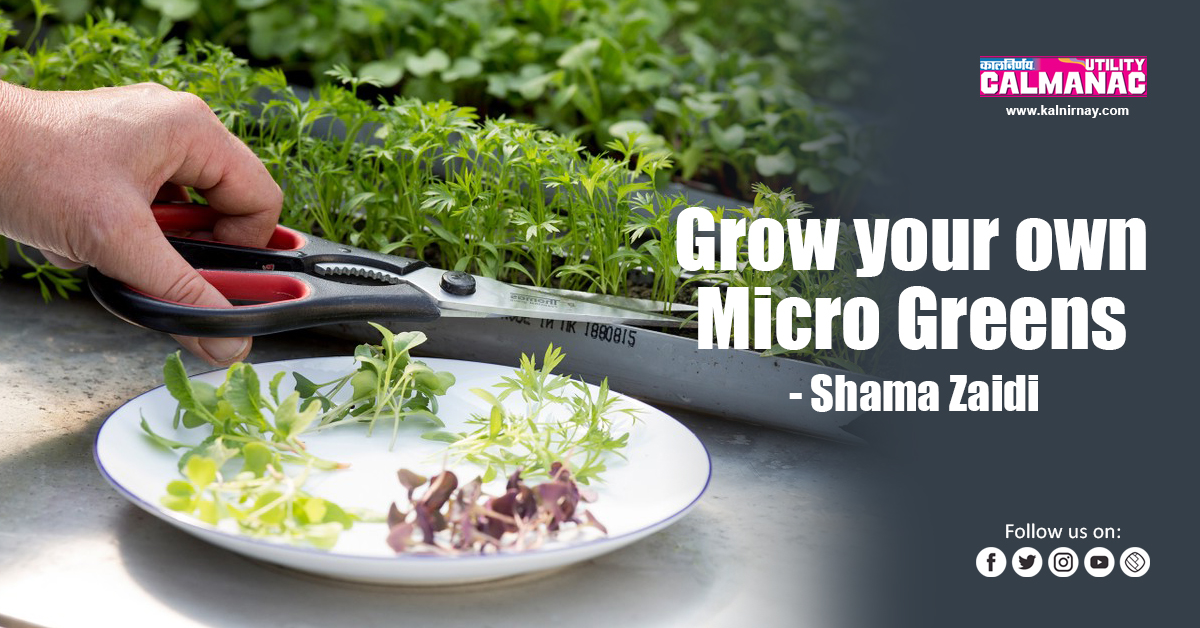Grow your own Micro Greens
Easy to grow, these little wonders are a powerhouse of nutrition.
Microgreens are young vegetable greens that are harvested when they are approximately 7-10 cms in height. They have an aromatic flavor and concentrated nutrient content and come in a variety of colors and textures. Microgreens are very convenient to grow, as they can be grown in a variety of locations, including outdoors, in greenhouses, and even on your windowsill.
Types of Microgreens
Microgreens can be grown from different types of seeds.
The most popular varieties are produced using seeds are Cauliflower, broccoli, cabbage, watercress, radish and arugula, lettuce, dill, carrot, fennel, celery, garlic, onion, leek, Amaranth, quinoa swiss chard, beet and spinach, Melon, cucumber, and squash.
Cereals such as rice, oats, wheat, corn, and barley, as well as legumes like chickpeas, beans, and lentils, are also sometimes grown into microgreens and consumed.
Microgreens vary in taste, which can range from neutral to spicy, slightly sour, or even bitter, depending on the variety. Generally speaking, their flavor is considered strong and concentrated.
Microgreens Are Nutritious
l Microgreens are packed with nutrients. They often contain higher vitamin, mineral, and antioxidant levels than the same quantity of mature greens. Nutrient levels in microgreens can be up to nine times higher than those found in mature greens
l While their nutrient contents vary slightly, most varieties tend to be rich in potassium, iron, zinc, magnesium, and copper.
l Microgreens are also a great source of beneficial plant compounds like polyphenols and other antioxidants than their mature counterparts and can contain up to 40 times higher than those recorded for more mature leaves
Health Benefits of Microgreens
Microgreens contain similar and often greater amounts of these nutrients than mature greens. As such, they may similarly reduce the risk of the following diseases :
- Heart disease: Microgreens are a rich source of polyphenols, a class of antioxidants linked to a lower risk of heart disease.
-
Alzheimer’s disease: Antioxidant-rich foods, including those containing high amounts of polyphenols, may be linked to a lower risk of Alzheimer’s disease
Diabetes: Antioxidants may help reduce the type of stress that can prevent sugar from properly entering cells. In lab studies, fenugreek microgreens appeared to enhance cellular sugar uptake by 25–44%.
l Certain cancers: Antioxidant-rich fruits and vegetables, especially those rich in polyphenols, may lower the risk of various types of cancer. Polyphenol-rich microgreens may be expected to have similar effects.
How to Include Microgreens in Your Diet
There are many ways to include microgreens in your diet.
- They can be incorporated into a variety of dishes, including sandwiches, wraps, and salads.
-
Microgreens may also be blended into smoothies or juiced. Wheatgrass juice is a popular example of a juiced microgreen.
-
Another option is to use them as garnishes on pizzas, soups, omelets, curries, and other warm dishes.
How to Grow Your Own
Microgreens are easy and convenient to grow, as they don’t require much equipment or time. They can be grown year-round, both indoors or outdoors.
Here’s what you’ll need
l Good-quality seeds.
l A good growing medium, such as a container filled with potting soil or homemade compost. Alternatively, you can use a single-use growing mat specifically designed for growing microgreens.
l Proper lighting — either sunlight or ultraviolet lighting, ideally for 12–16 hours per day.
Instructions :
l Fill your container with soil, making sure you don’t over-compress it, and water lightly.
l Sprinkle the seed of your choice on top of the soil as evenly as possible.
l Lightly mist your seeds with water and cover your container with a plastic lid.
l Check on your tray daily and mist water as needed to keep the seeds moist.
l A couple of days after the seeds have germinated, you may remove the plastic lid to expose them to light.
l Water once a day while your microgreens grow and gain color.
l After 7–10 days, your microgreens should be ready to harvest.
The Bottom Line
Microgreens are flavorful and can easily be incorporated into your diet in a variety of ways.
They’re also generally very nutritious and may even reduce your risk of certain diseases.
Given that they’re easy to grow at home, they’re an especially cost-effective way to boost nutrient intake without having to purchase large quantities of vegetables.
As such, they’re a worthwhile addition to your diet.
To read more English blogs, visit our blog section.

